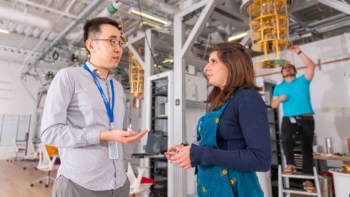
First there was Schrödinger’s cat, now an international team of physicists has come up with a new animal-related paradox involving “quantum pigeons”.
For nearly a century students have struggled to understand the many counter-intuitive implications of quantum physics. Perhaps the most famous paradox is Schrödinger’s cat, whereby a cat being both dead and alive at the same time illustrates the fact that a particle can exist simultaneously in two quantum states.
Now, Jeff Tollaksen of Chapman University in California and colleagues in Israel, Italy and the UK have proposed an equally bizarre scenario dubbed the “quantum-pigeonhole effect”. The paradox begins with the observation that when you put three pigeons in two pigeonholes, there will always be at least two pigeons in the same hole. But according to the team’s quantum analysis, it is possible for none of the pigeons to share a hole.
“It’s one of those things that seem to be impossible,” says Tollaksen. But it is a direct consequence of quantum mechanics and, he adds, “It really has immense implications.”
Nondeterministic measurements
Classical physics is deterministic. This means that measuring the initial state of a system will, in principle, tell you everything you need to determine the final state. But in 1964 Yakir Aharonov of Chapman University and Tel Aviv University helped discover that in quantum mechanics, you can choose initial and final states that are entirely independent, Tollaksen says.
Now Aharonov has teamed up with Tollaksen and colleagues to use this and other concepts of quantum mechanics to postulate the quantum-pigeonhole effect. They reckon that the effect will arise when an observer makes a sequence of measurements while trying to fit three particles in two boxes. First, you make an initial, “pre-selection” measurement of the locations of the particles. Next, you can perform an intermediate measurement to see whether two particles share a box. Finally, you make a final, “post-selection” measurement of the locations. You can make the pre-selection and post-selection measurements such that they are completely independent. In the intermediate step, you can make what’s called a weak measurement to look at all three particles simultaneously. And when you do, it turns out that no two particles share a box.
Spooky and profound
The implications of these results, Tollaksen says, complement the well-known Einstein–Podolsky–Rosen (EPR) paradox. In this scenario, two particles that start in the same place can become intimately correlated, a relationship called entanglement. Measuring the state of the first particle seems to influence the state of the second one, even if they are subsequently separated by distances so great that it would be impossible to explain the influence using classical physics. This unsettling conclusion led Einstein to call entanglement “spooky action at a distance”.
“EPR is one of the most profound discoveries in science,” Tollaksen says. “But that’s only half the story.” The quantum-pigeonhole principle creates a somewhat opposite situation, he explains. Three particles can begin separated with no connections or correlations at all. You bring them together and force them to interact by squeezing them in two boxes. During this intermediate stage, they are more strongly correlated than classically possible. But in the final stage, they are not correlated at all.
The implications of the EPR paradox are important and shape our understanding of information and the fundamental physics of matter. Although it is too early to predict every implication, he believes that the quantum-pigeonhole principle could prove to be just as influential – if not more so. “This is at least as equally profound, if not more profound,” he says. It implies a new concept of correlation that is surprising.
Electronic pigeons
To verify their conclusions, Tollaksen and colleagues propose an experiment in which three electrons travel through an interferometer. This is essentially a beam splitter that creates two separate paths for the electrons, which then meet again.
Because there are only two possible paths, you would expect at least two electrons to share a path. If so, then the two will be close together and interact: their identical electric charges will repel each other, slightly deflecting their trajectories. Then physicists will be able to detect these deflections when all three electrons reunite after the paths converge. But, Tollaksen says, because their calculations show that no two of the three electrons will actually follow the same path, no deflections will be observed.
Physicists have not done these experiments yet, but Tollaksen is confident in their results. “I’m sure it will be confirmed experimentally very soon,” he says.
The new results seem “fascinating,” says Leonard Susskind of Stanford University. “I would guess that the new effect is a serious step in understanding quantum correlations.”
The research is described on the arXiv preprint server.



